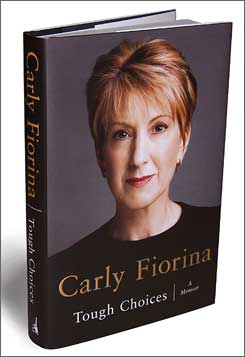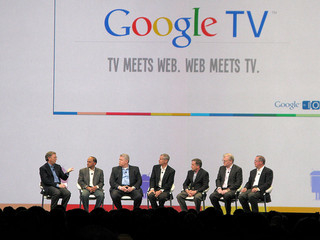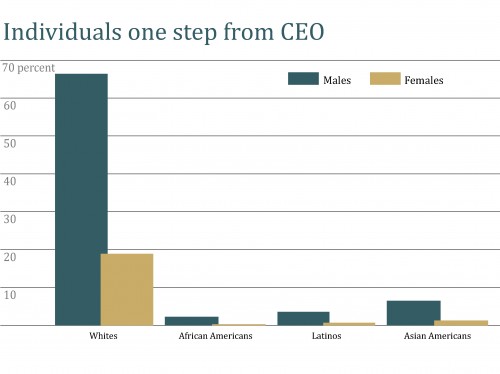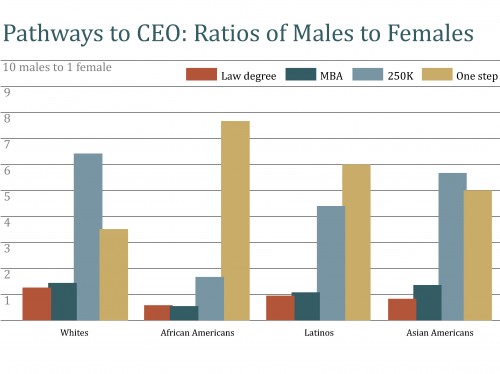Twenty years ago we wrote a book about African American teenagers from low-income backgrounds who went to elite boarding schools through a program called A Better Chance. We predicted: “It seems unlikely that more than two or three blacks will make it to the very top of a Fortune 1000 company in the next two decades, even with the cultural capital of prep school and Ivy League educations.” We were wrong. By spring 2011, 14 African Americans had become CEOs at Fortune 500 companies.
The trend moved rather quickly. When the first edition of our book, Diversity in the Power Elite, came out in 1998, we had to look at corporate directors, not CEOs, as there just wasn’t enough diversity among CEOs to study. By the second edition, eight years later, there were 46 women and people of color in the corner office of top firms. Indeed, every few months, a Fortune 500 corporation appoints a CEO who is not a white male—that is, they select one of what we call “The New CEOs.” In October 2011, IBM tapped Virginia Rometty, a white woman; in late March 2012, McDonald’s chose Don Thompson, an African American male; and in early April 2012, Avon announced Sherilyn McCoy, a white woman, would replace Andrea Jung, the Chinese American woman who had been its CEO since 1998. With McCoy’s appointment, the tally of The New CEOs at Fortune 500 companies stood at 80 white women, African Americans, Latinos, and Asian Americans.
As we consider these changes, we are especially intrigued by the appointments of the first two African American CEOs of Fortune 500 companies in 1999, the subsequent appointments of 12 more by the time our book The New CEOs came out in 2011, and now one more in 2012 (Thompson at McDonalds). The New CEOs considered the group of 14 African Americans, 25 white women, 15 Latinos, and 20 Asian Americans just about every which way, including background (in terms of geography, class, and education), skin color, whether they were internal or external hires, their pay, which politicians they have supported, which companies appointed them, and whether those companies are rated positively by organizations and magazines like the Human Rights Campaign, the National Organization for Working Mothers, Fortune, and Working Mother, each of which rates corporations on good “corporate citizenship” and fair treatment of women and gay, lesbian, and transgender employees. We asked why there had been such an increase in CEO diversity even in the years of George W. Bush’s presidency. What could we learn about diversity and the power elite?
Here, with another year of information to draw upon, we look at the New CEOs in terms of class and gender, using an intersectional analysis to help explain who becomes a New CEO—and who does not.
Assessing Class and Other Differences

It’s very difficult to know a person’s wealth (or background of wealth), but, as various sociologists and economists have shown, wealth is a crucial predictor of life chances—better, even, than annual income. In the case of CEOs, it is especially difficult because they and their publicists go out of their way to be misleading: all CEOs, it seems, worked their way up from the bottom. Consider, for example, Carly Fiorina, the former CEO of Hewlett Packard and 2010 Republican Senate nominee in California. She is said to embody the American Dream, having climbed the corporate ladder from humble beginnings. In her memoir, Tough Choices, she writes of her “modest, middle-class family.” When she campaigned with John McCain in his 2008 presidential bid, he introduced her over and over again by telling audiences she “began as a part-time secretary.” In reality, Fiorina grew up a child of privilege. By her own account, before he became a federal judge, her father taught law at the University of Texas, Cornell, Yale, Stanford, and Duke; his sabbaticals took the family around the world, including one stop in London where she attended the posh-sounding Channing School for Select Young Ladies. At four, she was already taking French lessons and going to the opera. She may very well have been a part-time secretary, but to suggest that she moved from anywhere near the bottom of the class structure to the top is a bedtime story.
So, to assess the class backgrounds of the New CEOs, we did what sociologists usually do—we used the best information available to determine their parents’ (and sometimes grandparents’) occupations and educational levels. Among the white women, we concluded about 70% came from upper middle or upper class families (that is, the top 15% of the class structure). The 70% figure closely follows estimates made by other academics who have systematically studied the class backgrounds of top corporate executives. Similarly, a look at the Latino CEOs, all of whom have been male and most of whom were born and raised outside the United States, shows about two thirds came from upper middle or upper class families.
Among the 20 Asian American Fortune 500 CEOs (a fairly loose category that included not only Japanese and Chinese Americans, but also eight CEOs who were born in India, one in Sri Lanka, and one in Pakistan; just one quarter of the Asian American CEOs were born in the United States, but most have become American citizens), we concluded that most were from the upper middle or upper classes of the countries in which they grew up. Three of the Asian Americans are women: Andrea Jung, CEO of Avon from 1999 until just recently; Indra Nooyi, CEO of Pepsi Cola since 2006; and Laura Sen, CEO of BJ’s Wholesale Club since 2009. Despite Jung’s claim that her Chinese immigrant parents “had nothing when they came here,” her father was an architect and her mother a chemical engineer. Even if they came without economic capital, they came with cultural capital including advanced education and valuable occupational experience. Jung went to Princeton where she majored in English literature. Nooyi, whose father was a banker and whose aunt was a noted classical musician, came to study at Yale after graduating from college in India, and at one time described herself as “a good, conservative, south Indian Brahmin girl.” Sen’s Chinese father was a highway engineer; her Irish mother worked as a secretary.
Only the 14 African American CEOs break the pattern: most are not from economically privileged families. More typically, as is the case for Richard Parsons, former CEO of Time Warner and until recently the chair of Citi, they come from working class families in which money was tight, but they did not grow up thinking they were poor (Parsons explained in one interview, “when I was a kid… I had absolutely no idea that we were statistically working poor. We were like everyone else on the block; it didn’t seem so bad to me”). Though some, like Kenneth Chenault, CEO of American Express since 2001, came from professional families that were well-off (his father was a dentist), many grew up with parents who were factory workers, postmen, custodians, day-care workers, or house cleaners. The single African American woman in this group, Ursula Burns (CEO of Xerox since 2009), was raised by a single mother who took in ironing.
With the exception of the African Americans among them, the New CEOs share the same class backgrounds as the “Old CEOs”—the white men who previously held these positions and still make up 93% of the Fortune 500CEOs. The white women CEOs certainly are similar in terms of class background to the white male CEOs, as are the Latinos and the Asian Americans.

Almost 15 years ago, when we looked at the women who had served as corporate directors of Fortune 500 companies, we found that they were better educated than their white male counterparts. They were more likely to have attended elite colleges and universities and to have earned post-graduate degrees. The same pattern holds for the women CEOs. These findings support the oft-asserted claim that in order to advance in a world that discriminates, women (and other groups facing such discrimination) have to be better educated and perform better than their white male competition. The exceptions, however, reveal the importance of scholarship programs that allow those from the lower rungs of the class structure to attend elite boarding schools, excellent undergraduate colleges and universities, and graduate schools. For example, after a stellar career at a public high school in Seattle that included serving as student body president and quarterbacking the football team, Franklin Raines, the former CEO of Fannie Mae, won a Harvard scholarship. After attending Catholic schools and NYU, Xerox’s Ursula Burns won a fellowship (paid for by Xerox) that covered her graduate school education at Columbia University. These exceptions to the general rule (that class privilege is key to one’s chances of becoming a CEO) demonstrate the importance of scholarships and other educational aid.
Playing the Corporate Game
When we first looked at the experiences of women in the corporate world, we found that many complained about issues related to golf. Women executives told researchers and journalists that the amount of business taking place on the “back 9” put them at a disadvantage. Hazel O’Leary, a former corporate executive who became secretary of energy in the Clinton administration, told an interviewer that she felt she had to take up the sport. “Without losing your own personality,” she explained, “it’s important to be part of the prevailing culture. At this company it’s golf. I’ve resisted learning to play golf all my life but I finally had to admit I was missing something that way.”

Golf remains an issue today: even if women learn how to play, they may not be included, and some courses don’t allow them anyway. Lloyd Ward, one of the African American CEOs on our list (he was CEO of Maytag from 1999 to 2000), took some heat when it was revealed that he was one of the few African American members of the Augusta Country Club, home of the Masters Golf Tournament and a club that continues to bar women from membership. More recently, Augusta’s policy came under scrutiny because IBM sponsors the Masters Tournament—IBM’s own CEO, a woman, wouldn’t be allowed to play there. Aylwin Lewis, another of the African American Fortune 500 CEOs (Kmart/Sears, from 2004 to 2008), at one point issued a decree that, at his company, there could be no discussion of business matters on the golf course. He refused to leave important company players out of the loop just because they were not golfers (or were not invited to play).
Going further, many have argued that, because women have had fewer opportunities to participate in organized team sports (and, thus, to learn the leadership skills, teamwork, and other character-building attributes allegedly tied to participation in organized sports), they have been disadvantaged in the corporate world. This may be. We did find some younger women CEOs who’d grown up with Title IX and played competitive sports in high school and college. For example, Meg Whitman, former CEO of eBay and current CEO of Hewlett Packard, played field hockey and lacrosse in high school and at Princeton. But, here again, class and education intersect with opportunity. How does one learn to play golf, field hockey, or lacrosse? For a host of reasons, including the costs of playing these sports and the necessary time investments by kids and their parents, a disproportionate number of those who play certain sports hail from the privileged classes or had scholarships to tony private schools, and they are less likely to have played what are sometimes called “prole” (or “proletarian”) sports like basketball. We did find that many of the African American male CEOs—the one group of New CEOs, you will recall, that did not tend to come from privilege—had played “prole” sports at the high school or college level, but that crucial intersection of class, education, and gender seems to have effectively kept both women and those from the lower classes from participating in upper-crust sports or gaining the social capital such sporting networks might provide.
Learning from the Pipeline
How will class, education, gender, and other factors help shape future appointments of white women, African Americans, Latinos, and Asian Americans as Fortune-level CEOs? We looked at some key points in the executive pipeline that typically are part of the path to the corner office: graduating from college, earning MBA or law degrees, earning more than $250,000 per year, and, probably most importantly, attaining a senior executive position in a Fortune 500company that is just one step from the CEO office. The first three of those indicators are available as part of national data sets. To check on the last, we looked up Fortune 500 companies online and used photos of the “management team,” “executive team,” “senior leadership committee,” or other groups of senior-most executives. With two separate student opinions as to the distribution of women, African Americans, Latinos, and Asian Americans in photos of 3,072 individuals across 262 companies, we concluded that about two-thirds of those a step from the CEO office were white men, about 19% were white women, slightly fewer than 3% were African Americans, about 4% were Latinos, and about 8% were Asian Americans (see Table 1 below).

These data place the much-smaller percentages of women CEOs of color in stark relief: there are no such differences earlier in the executive pipeline. In fact, far more African American women earn college degrees, MBAs, and law degrees than African American men, and about as many Latinas and Asian American women earn these degrees as Latinos and Asian American men. However, when we look at the steps that approach the CEO office more closely (those earning $250,000 a year and those just one step from the CEO office), women of color almost disappear.
To show this more clearly, in Table 2 (below) we have summarized the ratios of men to women for each of four potential steps to the CEO office. With the exception of African Americans, the ratios are not too high either in favor of men or women for the first two categories, but they diverge in the third and fourth steps: that is, men are much more likely to earn those big salaries and much more likely to be one step from the CEO office. In that last, most important category, the male to female ratio is highest for the three ethnic groups (African American, Latino, and Asian American), with men much more likely to hold such positions than women.

In one of our earlier books, we argued that, in order to make it through the diversity gauntlet, an aspiring non-white-male executive could not be too different from the white males who made up, and still make up, the majority of the power elite. It was as if the diversifiers lost points, so to speak, for each category of difference. For example, a black male lost one point, but a black female lost two points. It’s a crude numerical way of saying, as social psychology studies reveal, in-groupers look for commonality when they consider bringing in allies from among traditional out-groups. But even white males could lose points for having dreadlocks or wearing a yarmulke.
Back in the 1980s, in an interview study of executives who had received MBAs from Harvard Business School, female Jewish executives all agreed that being female was more of an impediment to their careers than being a Jew, but many quickly emphasized that being Jewish, or different in any other way, was not irrelevant. As one put it, “It’s the whole package. I heard secondhand from someone as to how I would be perceived as a pushy, Jewish broad who went and got an MBA. Both elements, being Jewish and being a woman, together with having the MBA, were combined to create a stereotype I had to work against from the first day.” Another woman explained, “It’s part of the question of whether you fit the mold. Are you like me or not? If too much doesn’t fit, it impacts you negatively.” Our current findings suggest that this becomes increasingly apparent the closer one gets to the CEO office.
With this kind of a crude metric in mind, it is not surprising that there have been far more white women CEOs (26 and counting) than African American women CEOs (1), Asian American women CEOs (3), or Latino women CEOs (none). The data we’ve gathered showing who is one step from the CEO office lead us to conclude that these patterns will continue. Culture (in the form of cultural capital), education, and class are all still in play. While gender and color remain the best predictors of who will make it into the upper echelons of the corporate world, beyond that, it’s intersectionality wherever we look.
Click here to listen to an Office Hours interview with Richard L. Zweigenhaft about The New CEO’s.
Recommended Reading
Denise Benoit. 2007.The Best-kept Secret: Women corporate lobbyists, policy, & power in the United States. Shows how women with expertise in finance and taxes became useful to corporations that wanted to maintain access to Congress, especially when more women became important members of the legislative process as elected officials and staff members of finance committees.
Sharon M. Collins. 1997. Black Corporate Executives: The making and breaking of a black middle class. An in-depth look at the experiences of black corporate executives before there were any black CEOs.
Dennis Gilbert. 2011. The American Class Structure in an Age of Growing Inequality, 8th edition. Provides a valuable model for understanding class in America.
C. Wright Mills. 1956. The Power Elite. A classic that shows the absence of diversity in the highest circles of the corporate, political and military worlds in the 1950s. Mills was more focused on the over-representation of those from the highest classes than the underrepresentation of women and people of color.
Thomas M. Shapiro and Melvin L. Oliver. 2006. Black wealth-white wealth, 2nd edition. Not only are there black-white wealth gaps, they are growing. This book explores the hidden costs of being African American that perpetuate inequality.

Comments 3
Denise — August 28, 2012
I just finished a biography of Genghis Khan - he came from a very poor, improvished background and pulled himself up through sheer will. I think coming from a poor background, then being given opportunity brings together a holistic view of the world that can make great leaders.
New CEOs: The Diversification of the Corner Office » Sociological Images — November 8, 2013
[…] a discussion about their book, The New CEOs, at The Society Pages, they ask whether the rise of non-white/non-male CEOs is really a disruption in the distribution of […]
What If The Glass Ceiling Isn’t What We Think It Is? — December 2, 2015
[…] a huge price thanks to the glass ceiling’s existence, but we’re not alone. One could argue that minorities pay an even larger price, but I think these demographic realities overshadow a psycho-graphic shift that is even more […]